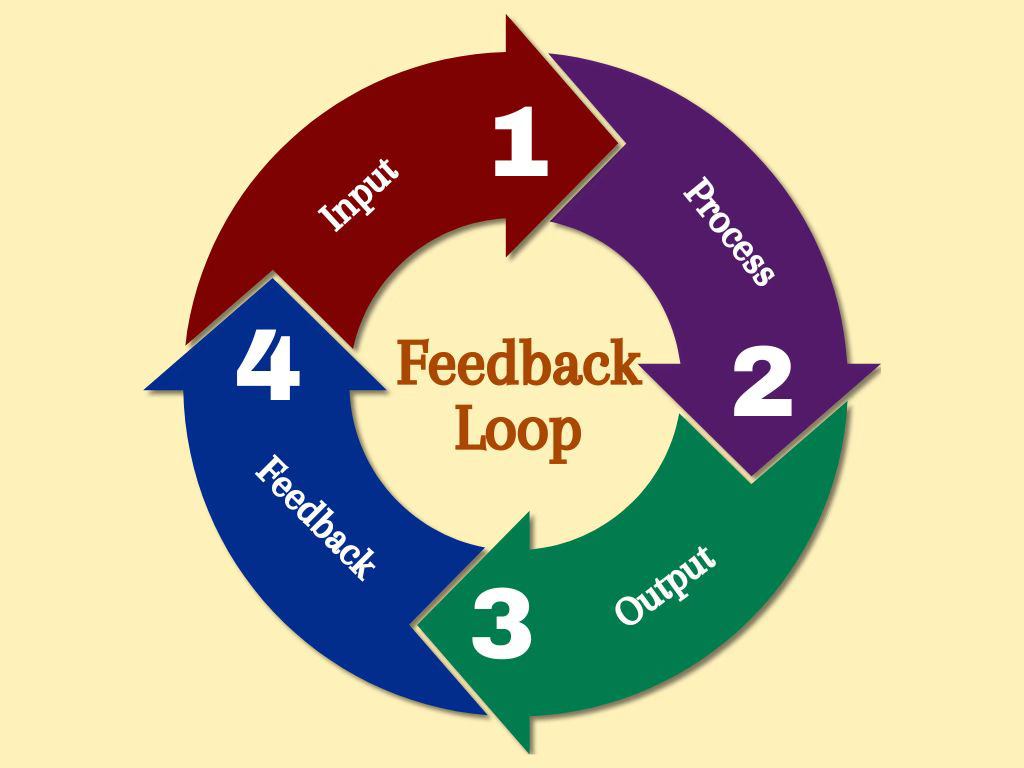Feedback Loops
We are all influenced by feedback. If you touch a hot stove, you almost immediately feel pain and pull your hand away. That’s a feedback loop in action.
One definition of a feedback loop is the part of a system in which all or part of the system’s output becomes input for future operations. The pain in touching the stove guides the movement of the hand away from the stove.

We find feedback loops all around us. If you are driving just a little too fast, and pass one of those automatic radar signs that flash your speed, most people (surprisingly) slow down. That’s a feedback loop in action.
Technically, there are two kinds of feedback loops, positive and negative. This can be a little confusing, because the definitions change in different disciplines, but generally positive feedback doesn’t mean the information received was good. Positive feedback just increases the base activity, and negative feedback decreases it.
Here’s an example: when someone is wounded, a chemical causes platelets in the blood to start clumping together. This group of platelets releases more chemicals, which causes more platelets to join them. This continues until the platelets form a clot that seals the wound. We would consider a wound to be a bad thing, but the activity (platelet clotting) was increased. So this is a positive feedback loop.
All feedback loops look generally like this:
Positive feedback
In the Arctic, our warming planet has meant less ice throughout the year. Since ice reflects sunlight, less ice means that more sunlight is absorbed by the water, making the oceans even warmer, leading to even less ice. This is a positive feedback loop. (We are getting warmer and warmer.) If we don’t do something about it, there will soon be no ice in the Arctic at all.
Negative feedback
In the NFL draft, the worst team in the league gets the first pick in the next draft, hopefully decreasing the advantages of good teams, and making the league more competitive. This is a negative feedback loop, because the activity (teams getting better and better) is reduced.
Marketers
In the retail world, retailers all want to know how they’re doing. Was that five stars, or three? Why was that? They use the surveys we fill out to determine if the product in question needs to be changed, or if the price needs to be changed, or if the service was adequate. Without this information, products may lose out to competitors with better feedback.
There are even some ways that companies collect information from us without us knowing it. How long did you look at that product ad on Facebook? Did you navigate to a product website? They know all the moves we make on the internet, and the information is collected to tell them how they are doing in real time.
Lack of Loops
Problems are often created when feedback is not available. Think about nutrition. How do we know that what we are eating is the right thing? We are told what is healthy and what is not, but the advice shifts over time. And when we eat something unhealthy, we don’t see the results right away. Our waistlines don’t suddenly increase, and we don’t feel a decrease in energy immediately. So it’s important to get timely feedback.
There is a condition that causes a person to lose the ability to feel physical pain. It is called Congenital Insensitivity to Pain and Anhydrosis (CIPA). It is extremely rare, but in people who have this condition, there is a near certainty that they will suffer damage to their bodies, often losing limbs or digits. This all happens because one of their feedback loops is missing.
Personal feedback loops can be a little distorted. People trying to be polite will say nice things, but keep criticism to themselves. No one likes to hear negative comments, but without them we will never improve. If you have someone in your life who tells it to you straight, you’re lucky.
Do you want to change something in your life? Create a feedback loop that keeps you on the right course. Want to lose weight? Just weigh yourself regularly. Want to read more? Just mark your calendar every day you read a book. Feedback loops are incredibly simple and effective. But most people don’t consciously use them. You could become one of the outliers.



